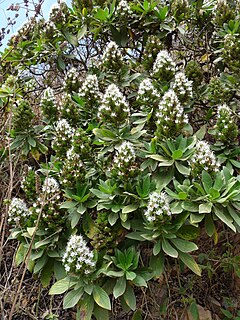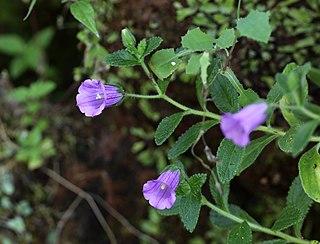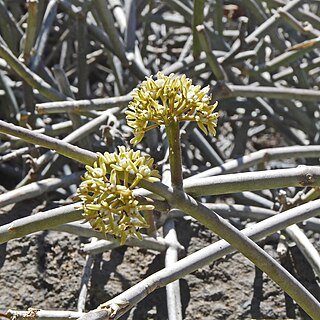
Umbilicus schmidtii is a flowering plant in the family Crassulaceae. The species is endemic to Cape Verde. It is listed as endangered by the IUCN.

Artemisia gorgonum is a species of flowering plants of the family Asteraceae, endemic to Cape Verde. Its local name is losna or lasna. The plant plays a role in traditional medicine.

Euphorbia tuckeyana is a species of flowering plants of the family Euphorbiaceae. The species is endemic to Cape Verde. The species is named after James Hingston Tuckey. Its local name is tortolho. The plants are used for tanning hides.

Echium hypertropicum is a species of flowering plants of the family Boraginaceae. The species is endemic to Cape Verde. It is listed as an endangered plant by the IUCN.
Micromeria forbesii is a species of flowering plants of the genus Micromeria. The species is endemic to Cape Verde. It is listed as endangered by the IUCN. It was first described by George Bentham in 1834. Its local name is erva-cidreira, or cidreirinha. In traditional medicine, it is used as an infusion for the treatment of indigestion, diarrhea, cough and to stimulate labour.

Campanula jacobaea is a species of flowering plants of the Campanulaceae family. The species is endemic to Cape Verde and is listed as vulnerable by the IUCN. Its local name is contra-bruxas-azul. The plant is used in traditional medicine. Campanula jacobaea is shown on a Cape Verdean $5 escudo coin issued in 1994.
Limonium jovibarba is a species of flowering plants of the family Plumbaginaceae. The species is endemic to Cape Verde. It is listed as critically endangered by the IUCN. The species was named by Carl Ernst Otto Kunze in 1891. Its local name is carqueja, a name that may also refer to the related species Limonium brunneri and Limonium braunii.
Sonchus daltonii is a species of flowering plants of the family Asteraceae. The species is endemic to Cape Verde. It is listed as endangered by the IUCN. The genus was named by Philip Barker Webb in 1849. Its local name is coroa-de-rei.
Limonium brunneri is a species of flowering plants of the family Plumbaginaceae. The species is endemic to Cape Verde. It is listed as critically endangered by the IUCN. The species was named by Carl Ernst Otto Kunze in 1891. Its local name is carqueja, a name that may also refer to the related species Limonium braunii and Limonium jovibarba.
Limonium braunii is a species of flowering plants of the family Plumbaginaceae. The species is endemic to Cape Verde. It is listed as an endangered plant by the IUCN. The species was first described by the German Carl August Bolle as Statice braunii and was placed in the genus Limonium by the French Auguste Chevalier in 1935. Its local name is carqueja, a name that may also refer to the related species Limonium brunneri and Limonium jovibarba.
Conyza feae is a species of flowering plant that belong to the family Asteraceae. The species is endemic to Cape Verde. It is listed as an endangered plant by the IUCN. First described as Nidorella feae, it was placed in the genus Conyza by Hiram Wild in 1969. The specific name feae refers to the Italian naturalist Leonardo Fea. Its local name is losna-brabo or losna-bravo. The plant plays a role in traditional medicine.

Conyza varia is a species of flowering plants of the family Asteraceae. The species is endemic to Cape Verde. It is listed as an endangered plant by the IUCN. First described as Erigeron varius by Philip Barker Webb, it was placed in the genus Conyza by Hiram Wild in 1969. Its local name is marcelinha or tabua, tabuinha. The plant plays a role in traditional medicine: crushed and heated leaves are used to treat external inflammations.
Conyza pannosa is a species of flowering plant in the family Asteraceae. The species is endemic to Cape Verde. It is listed as an endangered plant by the IUCN. The plant was named by Philip Barker Webb in 1849. Its local name is taba.

Sarcostemma daltonii is a species of flowering plants of the family Apocynaceae. The species is endemic to Cape Verde. The specific name refers to Joseph Dalton Hooker. The species was named by Joseph Decaisne in 1849. Its local name is gestiba. The plant is used in traditional medicine to relieve and treat dental problems.

Asteriscus smithii is a species of flowering plants of the family Asteraceae. The species is endemic to the island of São Nicolau, Cape Verde. It is listed as critically endangered due to its very restricted area of occupancy and its low population size. Its local name is macela-de-gordo.
Conyza schlechtendalii is a species of flowering plant in the family Asteraceae. The species is endemic to Cape Verde. It is listed as critically endangered by the IUCN.
Launaea gorgadensis is a species of flowering plants of the family Asteraceae. The species is endemic to Cape Verde. It is listed as a critically endangered plant by the IUCN.
Launaea picridioides is a species of flowering plants of the family Asteraceae. The species is endemic to Cape Verde. It is listed as a vulnerable species by the IUCN.
Limonium sundingii is a species of flowers that belong to the family Plumbaginaceae. The species is endemic to Cape Verde. It is listed as critically endangered by the IUCN.
Papaver gorgoneum is a species of flowering plants of the family Papaveraceae. The species is endemic to Cape Verde. It is listed as critically endangered by the IUCN.








